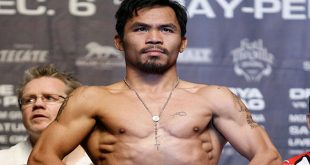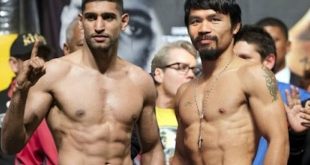Boxing fans are an intense, excitable bunch. I should know, I am one of them. Most every boxing fan remembers the fight or fighter that got them interested in the sport. In my case, it was the first Ali-Frazier fight, back in 1971. The buildup prior to the fight was huge, at least by 1971 standards. I still remember reading a long, interesting article in Sports Illustrated a week or so before the fight. The boxer versus the puncher. The article beautifully depicted the upcoming fight as not just a boxing match, but as a battle between two very dissimilar men with a genuine dislike for one another. Before that fight, boxing never interested me. But like thousands (maybe millions) of others, I got caught up in the hype. I remember rooting for Ali right from the start. If the sense of anticipation was great, the fight more than lived up to the hype. Although Ali lost the fight, the result punctuated by Frazier’s left hook, which floored Ali in the fourteenth round; the fight was an instant classic. From then on, I was hooked. I had become a boxing fan.
I began following boxer’s careers, watching every fight I could, and becoming more knowledgeable about the sport. The atmosphere at major championship bouts always captivated me. I found that, much like World Cup soccer matches many major championship fights had that international flavor that generated so much electricity. Being a native Puerto Rican, I quickly got caught up in the amazing rivalry that has existed through the years between Puerto Rican and Mexican fighters.
I loved the classic fights of the eighties: Duran vs. Leonard, Leonard vs. Hearns, Arguello vs. Pryor, Hagler vs. Hearns. It was a time when many great champions co-existed. My own little island had Wilfredo Gomez, Wilfredo Benitez, Edwin Rosario, and several other champions.
During the late seventies and early eighties, I thought of boxing as just a sport, unaware that there could be terrible consequences from a boxing match. Then came November of 1982. I remember watching the terrific fight between Ray “Boom Boom” Mancini and a tough Korean named Deuk Koo Kim. It was a terrific battle, with both fighters absorbing a lot of punishment. But then, Kim died following the fight as a result of injuries to his brain, and I discovered the dark side of boxing. What I remember most about the aftermath of the fight and Kim’s death was how Howard Cosell, a fight announcer for many years prior to this fight, quit the sport in disgust over the death. It was this death that prompted the WBC to reduce the length of championship fights from fifteen rounds to twelve, with the other organizations following suit some years later.
Through the years, I have seen boxing at its best and its worst. I have seen classic fights that I would watch over and over again, but I have also seen many of the problems that plague boxing and come to the forefront from time to time: questionable judging, numerous champions in the same weight divisions, unscrupulous promoters, and others. But the one issue that has sometimes threatened the very existence of the sport has been the incidence of deaths and serious injuries in the ring.
No one likes to see a fighter die or suffer permanent disability from injuries incurred in the ring. But boxing, by its sheer nature, seems to walk that tightrope between great battles and beatings that can injure or kill a man.
Recently, there has been criticism from some fans regarding what appears to be a rash of fight stoppages while the fighter is in the corner between rounds. In the eyes of some fans, this is basically “quitting.” And the point can be made that, with the increase of pay-per-view fights where fans are being asked to shell out hard-earned money to watch two boxers go at it, it’s tough to stomach watching a fighter just give up. There have been many infamous cases of quitting. Perhaps the most infamous of all (at least in my mind) was the Roberto Duran “No Mas” against Sugar Ray Leonard in their second fight. I remember being very angry at how that fight ended, and being very embarrassed for Duran.
But where do you draw the line? This past week, ESPN’s Sportscenter featured a three-part series on boxer Beethaeven Scottland, a light heavyweight who died several days after being TKO’d by George Jones in June of 2001. I found it riveting how, even after Scottland endured a thorough beating in the previous rounds of the fight, he somehow came out in the ninth round and apparently won it by outfighting Jones. However, in the next round, Jones resumed his earlier domination and finally ended the fight by knocking out Scottland. Scottland never recovered and died several days later.
In retrospect, when would have been an appropriate time to stop the fight? Who knew what would happen? Apparently, Scottland was a late substitution for the originally scheduled opponent for Jones that night. Whether this is a factor worth considering, nobody knows.
Earlier this year I had the privilege of watching the Diego Corrales-Jose Luis Castillo fight. I watched this fight many times over; it was incredibly exciting. Both fighters absorbed a lot of punishment over the course of the fight. But what if one of the corners had stopped the fight prematurely? When Corrales was knocked down twice in the tenth round, what if the fight had been stopped then? Many say it probably should have been stopped. But what happened afterwards put the “icing on the cake” as far as Fight of the Year is concerned. Corrales got up and took out Castillo in dramatic fashion. Both are still very much active and presumably in excellent condition.
If looked at by decades, ring deaths have been on the increase since the seventies. In fact the seventies represent the bottom of the curve regarding ring deaths (since the beginning of the twentieth century), with “only” two deaths. Since then, the frequency has increased (seven in the eighties, eleven in the nineties, thirty-three since 2000).
Many of the deaths in the current decade have been in Indonesia and other countries in that general region, raising the possibility that the rules of the sport in those countries may need further evaluation. Also, the reporting of ring deaths in previous decades may or may not have been consistent throughout the history of the sport. Nevertheless, any death is one death too many, and measures should continue to be taken in an attempt to rid the sport of needless deaths or permanent injury. What measures are currently being taken, and what measures should be taken, is a topic that is beyond the scope of this article.
The point I am trying to make here is that there is a core of boxing fans that truly enjoy the sport. There is nothing quite like the excitement of a championship fight, complete with the pre-fight hype, the weigh-in, the ring entrances, the introductions, and obviously the fight itself. I have been fortunate enough to be able to attend a few fights live, and the experience is more satisfying than I had imagined.
Thus, whatever needs to be done to ensure the survival of the sport should be done with due diligence. So that maybe there will be more epic fights for many years to come.
Reynaldo Sambolin can be reached at RSAMBOLIN@libertypr.net
 Boxing News Boxing News
Boxing News Boxing News






